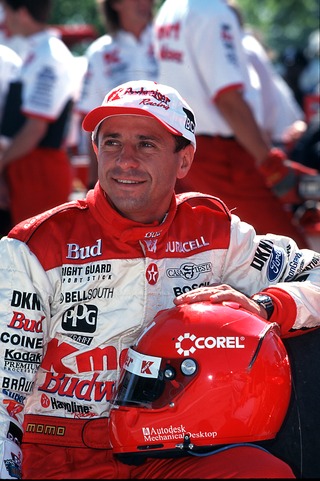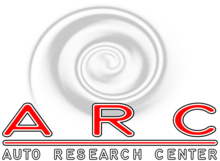
Richard Ravon Mears is a retired American race car driver. He is one of four men to win the Indianapolis 500 four times and is the current record-holder for pole positions in the race with six. Mears is also a three-time Indycar series/World Series champion.
California Speedway was a 2.000 mi (3.219 km), D-shaped oval superspeedway in unincorporated San Bernardino County, California, near Fontana. It hosted National Association for Stock Car Auto Racing (NASCAR) racing annually from 1997 until 2023. It was also previously used for open wheel racing events. The racetrack was located 47 mi (76 km) east of Los Angeles and was near the former locations of Ontario Motor Speedway and Riverside International Raceway. The track was last owned and operated by NASCAR. The speedway was served by the nearby Interstates 10 and 15 as well as a Metrolink station located behind the backstretch.
Lola Cars Limited is a British automobile manufacturer founded in 1958 by Eric Broadley in Bromley, England. The company is now owned by Till Bechtolsheimer, which he purchased in 2022. Lola Cars endured for more than fifty years to become one of the oldest and largest manufacturers of racing cars in the world. Lola started by building small front-engine sports cars, and branched out into Formula Junior cars before diversifying into a wider range of sporting vehicles. In 2012, Lola Cars stopped operations. Lola is set to make a return to motorsport in 2024 by joining the Formula E World Championship as an entrant and a powertrain supplier in a technical partnership with Yamaha.

Phoenix Raceway is a 1-mile, low-banked tri-oval race track located in Avondale, Arizona, near Phoenix. The motorsport track opened in 1964 and currently hosts two NASCAR race weekends annually including the final championship race since 2020. Phoenix Raceway has also hosted the CART, IndyCar Series, USAC and the WeatherTech SportsCar Championship. The raceway is currently owned and operated by NASCAR.

Roberto Pupo Moreno, usually known as Roberto Moreno and also as Pupo Moreno, is a Brazilian former racing driver. He participated in 75 Formula One Grands Prix, achieved 1 podium, and scored a total of 15 championship points. He raced in CART in 1986, and was Formula 3000 champion before joining Formula One full-time in 1989. He returned to CART in 1996 where he enjoyed an Indian summer in 2000 and 2001, and managed to extend his career in the series until 2008. He also raced in endurance events and GT's in Brazil, but now works as a driver coach and consultant, and although this takes up a lot of his time, he is not officially retired yet, as he appears in historic events. Away from the sport, he enjoys building light aeroplanes.

Ilmor is a British independent high-performance motor racing engineering company. It was founded by Mario Illien and Paul Morgan in November 1983. With manufacturing based in Brixworth, Northamptonshire, and maintenance offices in Plymouth, Michigan, the company supplies engines and consultancy to the IndyCar Series and MotoGP.

Nazareth Speedway is a defunct auto racing facility in Lower Nazareth Township in the Lehigh Valley region of eastern Pennsylvania, which operated from 1910 to 2004. The racing facility operated in two distinct course configurations. In its early years, it was a dirt twin oval layout. In 1987, it was reopened as a paved tri-oval that measured just slightly under 1 mile.

New Hampshire Motor Speedway is a 1.058 mi (1.703 km) oval speedway located in Loudon, New Hampshire, which has hosted NASCAR racing annually since 1990, as well as the longest-running motorcycle race in North America, the Loudon Classic. Nicknamed "The Magic Mile", the speedway is often converted into a 1.600 mi (2.575 km) road course, which includes much of the oval.
The Barber Dodge Pro Series was a professional open-wheel auto racing series from 1986 to 2003. It was one of the first professional spec series for open-wheel racecars in North America. The races were primarily on road and street courses in North America, although the schedule did sometimes include a few ovals.

The 1996 Indy Racing League was the first season in the history of the series, which was created and announced on March 11, 1994 by the Indianapolis Motor Speedway, as a supplementary series to the established Indy Car World Series sanctioned by Championship Auto Racing Teams (CART) since 1979. It consisted of only three races, as the season concluded with the 80th Indianapolis 500 in May. Walt Disney World Speedway was completed in time to host the first ever event of the Indy Racing League (IRL), and Phoenix International Raceway switched alliances from CART to the IRL, in order to host the second event of the season. At the conclusion of the three-race schedule, Scott Sharp and Buzz Calkins ended up tied for first place in the season championship. With no tiebreaker rule in place, the two drivers were declared co-champions. Its creation, and the opposition of CART's teams and drivers to take part in it, marked the start of 'the Split', a 12-year period of competition between rival series at the top level of American open-wheel racing that had lasting negative effects in the sport.

William Theodore Ribbs Jr. is a retired American race car driver, racing owner, and sport shooter known for being the first African-American man to have tested a Formula One car and to compete in the Indianapolis 500. Ribbs competed in many forms of auto racing, including the Trans-Am Series, IndyCar, Champ Car, IMSA, and the NASCAR Cup Series and Gander Outdoors Truck Series. After retiring, he became a sport shooter in the National Sporting Clays Association.

Gualter Salles, is an open wheel race car driver. He raced in the 1997-2000 and 2003 CART seasons, as well as one Indy Racing League event, totalling 49 IndyCar starts overall. He also competed in Stock Car Brasil between 2001 and 2007.
Calvin "Cal" Wells III is a businessman and CEO of Legacy Motor Club. The former owner of PPI Motorsports, he later served as the executive vice president of operations at Michael Waltrip Racing, overseeing the day-to-day operations of the organization's three NASCAR Cup Series teams and one Nationwide Series team, until July 2011.

Trenton Speedway was a racing facility located near Trenton, New Jersey at the New Jersey State Fairgrounds. Races for the United States' premier open-wheel and full-bodied racing series of the times were held at Trenton Speedway.
Bruce Ashmore is a race car designer who designed and developed 11 championship winning IndyCars with two different race car manufacturers, first with Lola Cars and then with Reynard Motorsports.

The MAVTV 500 was an IndyCar Series race held at Auto Club Speedway in Fontana, California. The event represented a continuous lineage of open wheel oval racing in the Southern California-area that dates back to 1970. Since 2012, the event had been sponsored by MAVTV, a motorsports cable channel owned by Lucas Oil.

Reynard Motorsport was the world's largest racing car manufacturer in the 1980s. Initially based at Bicester and latterly at Reynard Park, Brackley, England the company built successful cars in Formula Ford 1600, Formula Ford 2000, Formula Vauxhall Lotus, Formula Three, Formula 3000 and CART.
Diane Holl is a British engineer who has worked in Formula One, Championship Auto Racing Teams (CART), and NASCAR. She is employed at the Hendrick Motorsports NASCAR team as director of vehicle engineering.
David John Pitchforth is an English engineer, and former managing director Jaguar Racing Formula One team.
The Mercedes-Benz Indy V8 engine, known as the Ilmor 265-D (1994), and later the Mercedes-Benz IC108 (1995-2000), is a powerful, turbocharged, 2.65-liter, Indy car racing V-8 engine, specially designed, developed, and built by Ilmor, in partnership and collaboration with Mercedes-Benz, to compete in the CART series; between 1994 and 2000.












